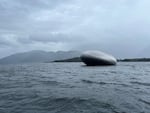
“The Salmon Eye,” run by Eide Fjordbruck, is an education center located at the mouth of Norway’s Hardangersfjord. It is the world’s largest floating art installation and a vision of the company’s CEO Sondre Eide.
Rob Schmitz
Jørgen Wengaard steers around the rocky islands of a fjord, his boat cutting through the water’s still surface, sending ripples toward silent forested shores. But here in the Hardangersfjord of western Norway, still waters run deep: more than 2,000 feet deep.
“The Norwegian coastline is perfect for farming Atlantic salmon,” says Wengaard. “We have the optimal temperature. We have good oxygen levels. We have the right salinity and the water is always changing due to strong currents. That’s very good for farming.”
Wengaard is headed to one of the fjord’s several salmon farms, known by their cylindrical pens made from nylon netting, some holding hundreds of thousands of salmon each under the surface of Hardangersfjord.
Norway is the world’s largest exporter of farmed salmon; more than a fifth of salmon consumed by Americans comes from the Nordic country. And as Norway exports more salmon across the world, the industry has come under criticism from environmental groups who say salmon farms are irreversibly impacting the pristine environment of Norway’s fjords.
Wengaard’s boat glides to a stop at a floating walkway surrounding two areas of open water, around 50 feet in diameter, lined with bright yellow nylon netting: a salmon farm run by the company Lingalaks. Wengaard, who’s worked much of his life on salmon farms, is a tour guide here.
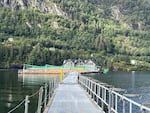
A salmon farm run by the company Lingalaks in the Hardangersfjord, Norway.
Rob Schmitz
“This is quite a small fish farm,” he says, climbing out of his boat. “We have two pens with only 15,000 salmon in each. That might sound like a lot, but on a regular-sized fish farm, they have one million salmon.”
Above these open water pens, a mechanical arm swivels in place, shooting out pellets of food. It prompts silver streaks in the water below: a feeding frenzy. The pens are home for these Atlantic Salmon from March to December. In those nine months, the fish grow to a weight between 10 and 15 pounds, and then they’re taken to a processing plant where they’re stunned before they’re slaughtered, filleted and exported around the world.
But for now, they’re here, eating and swimming, the only thing separating them from the open ocean is a thin nylon net.
“We need to inspect it every single day and look for holes, because we really don’t want the salmon to escape,” says Wengaard, pointing to a television screen inside the Lingalaks facility where the company is able to monitor both the health of the fish and whether the net holding them is compromised in any way.
“We don’t want them to mix with the wild salmon,” continues Wengaard. “So even though these salmon come from wild salmon originally, we don’t want them to mix their genes and destroy the spawning places for the wild salmon.”
But according to many industry experts, it’s too late for that.

Jørgen Wengaard, a tour guide at the Lingalaks salmon farm in Hardangersfjord, Norway, uses a mouse to steer the camera inside one of the farm’s open-net fish pens which holds 15,000 Atlantic Salmon.
Rob Schmitz
Hundreds of miles east of the fjords in the capital Oslo, author Simen Saetre sits on a bench at his local park beside the raging waters of the Akerselva River, where wild salmon, he says, can sometimes be seen, right in the middle of Norway’s biggest city.
“I’ve never fished it myself, but sometimes you see people in the river and they report nice catches,” he says.
Saetre, who co-authored The New Fish, a book about Norway’s salmon farming industry, says Norway’s wild salmon population has been cut in half in the past two decades largely due to the impact of tens of millions of farmed salmon. Each year, an average of 200,000 farmed salmon escape from their open net pens, a significant number when you consider that there are only an estimated 500,000 wild salmon left in the country, says Saetre.
“These farmed salmon then go and swim up to random rivers and then mate with wild salmon, and they weaken the wild salmon stock because these farmed salmon, they are made to be fat and slow and be effective for the industry,” says Saetre. “But when they mate with the wild salmon, the wild salmon offspring become slow and fat and easy to catch for predators.”
That’s a big reason, says Saetre, why Norway’s wild salmon stock is rapidly dying out. A study this year by the Norwegian Institute for Nature Research and the Institute of Marine Research found that nearly a third of wild salmon in Norway have “significant genetic changes” due to interbreeding with escaped farmed salmon. But Saetre says there is a bigger problem with Norway’s farmed salmon: sea lice. They’re tiny crustaceans that attach themselves to salmon, feed on them, and reproduce.
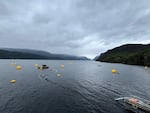
A pilot project run by the salmon farming company Eide Fjordbruck is a closed pen tank that holds 200,000 salmon. The closed pen protects the salmon from sea lice and prevents the salmon inside from escaping and interbreeding with wild salmon. The waste of the salmon is transported to a biogas tank, where its used to make energy.
Rob Schmitz
“These sea lice have lived for ages on wild salmon swimming by and attached to them,” says Saetre. “And then when you gather millions of big salmon in the fjords and the sea lice get into that, it’s like a heaven for the sea lice, and they grow and adapt.”
In a four-year study ending in 2020, Norwegian scientists discovered that in the fjords of western Norway mortality rates among farmed salmon from sea lice infestation reached more than 30%. Salmon farms use chemicals like pesticides to treat their fish, but scientists have discovered that sea lice have evolved to become resistant to the chemicals.
But one salmon farmer says he has a solution to all these problems.
In another part of the Hardangersfjord, Sondre Eide, the young third-generation CEO of his family salmon farming company Eide Fjordbruck, navigates his boat through the rain to what he calls his salmon farm of the future. When he arrives, Eide points to a black cylinder barely sticking out of the water, surrounded by floating gangplanks. It’s the cap of what appears to be a tank.
“This tank goes down 72 meters. If it were on land, it would be the highest building on the west side of Norway,” Eide says. “It holds 200,000 fish.”
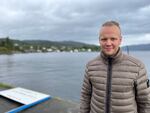
Sondre Eide, the third-generation CEO of Eide Fjordbruck, has spent tens of millions of dollars building a massive closed pen to try and innovate the salmon farming industry in Norway.
Rob Schmitz
This, says Eide, is closed pen salmon farming: no escaped salmon and no salmon lice.
“So it is all about giving the optimal life for the fish inside,” explains Eide. “And then, of course, when you take away the salmon lice, you have no salmon treatment, so you don’t have the handling, and that’s responsible for 60 to 70% of all the mortality in the industry. So then you can focus on how can we create the best lives for the fish instead of the next lice treatment.”
Eide and a team of his company’s engineers put years of work and hundreds of millions of dollars into this closed pen, which circulates ocean water into it and keeps lice out. It also filters out salmon waste – a big contributor to rising nitrogen levels in the fjords – by carrying it through a series of tubes to a separate tank where it eventually creates biogas which, in turn, can be used as energy to power this very facility, Eide’s next project.
Eide’s closed loop farming system raises the question: Why isn’t the entire industry farming salmon this way? While Norway’s government has been slow to explore this new technology, the government of Canada, another major salmon exporter, is phasing out open pens for its salmon farming industry to push companies to build pens like the one Eide has engineered. Eide says when he and his team looked for the technology to accomplish this, it simply wasn’t there. He had the money to try and build it, he says, so he did.
“For me, it was the right thing to do, and I 100% believe it from the bottom of my heart,” says Eide. “I know my father would have done the same today. My grandfather would’ve have done the same, too, because times change and we have to change with them.”
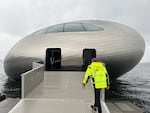
Sondre Eide built The Salmon Eye as an education center and Michelin-starred restaurant. It is the world’s largest floating art installation.
Rob Schmitz
To underscore this push for sustainable salmon farming, Eide climbs back into his boat and navigates it toward an even bolder project he’s built: the world’s largest floating art installation, just a 10-minute boat ride from his salmon farm. It’s a reflective silver orb that looks like a UFO that has crash-landed into the ocean. Eide calls it the Salmon Eye, and once our boat arrives to a dock attached to it, we enter what looks like a sleek lair of a James Bond villain, but what is actually an education center about threats to the environment.
Inside, visitors watch images projected on the walls and floor while hearing stories about an environment in peril before participating in a role play about the sustainability of salmon farming. After that, those who have managed to secure a reservation for Eide’s Michelin-Starred restaurant upstairs partake in an 18-course tasting menu of sustainable seafood.
“We need 50% more food towards 2050,” says Eide. “And we have used 50% of all useable land for food production. And we have only used 2% of the calories coming from the ocean, and yet we know less about the ocean than we do about space.”
And somewhere in these vast, deep, bodies of water, says Eide, lies the answer to feeding the world sustainably.